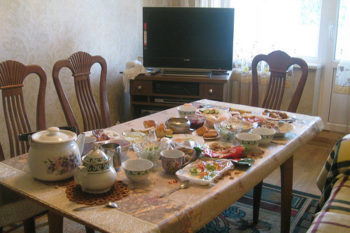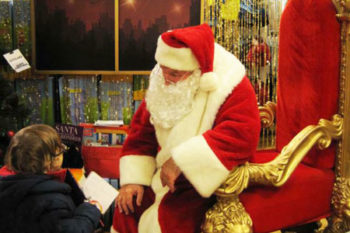November 2nd is Dia de los Muertos (“Day of the Dead”), a holiday celebrated in Mexico to remember the departed. Friends and family get together to remember and pray for dead relatives and friends, special foods are prepared and eaten, parties are sometimes thrown, and altars are graves are adorned with ofrendas (offerings) of flowers (especially marigolds), skeleton figurines, and pictures and other items that remind mourners of the deceased, or that were treasured by the deceased.

Grave adorned with marigolds (Source: Wikipedia)
Dia de los Muertos coincides with the Catholic holiday “All Souls Day,” and traditionally following gatherings at the house, a procession will make its way to the local cemetery to lay flowers and other items at graves of loved ones, and to pray. Special reverence may be given to Santa Muerte (Saint Death); not a saint in the traditional sense, but a kind of demigod treated as a saint, who is petitioned for special favors that other saints cannot grant.

Santa Muerte (Source: Wikipedia)
So why am I writing about a Mexican holiday? The US’s large Mexican immigrant and Mexican-American population has brought this tradition with them to the United States, and the parties and celebrations, particularly in major urban areas, can be incredibly ornate and beautiful. The stylized skeleton art associated with the celebration has basically become its own genre. The National Museum of Mexican Art in Chicago’s Pilsen neighborhood throws a party, and has a two month-long exhibit dedicated to art inspired by the Holiday, and it’s their most popular exhibit of the year. Some friends of mine often throw a party on November 2nd, and they construct an altar, encouraging party guests to bring pictures, mementos of loved ones, and ofrendas for them to display on the altar.

Home Altar (Source: Wikipedia)

TV Altar (Source: Wikipedia)
Anglo-America is typically not very comfortable with discussing death, or dying in general, evidenced in part by the hundreds of thousands of dollars in medical bills that many Americans incur (though insurance companies) in the last six months of their lives. Death is something to be avoided at all costs, and there is little, if any veneration or dignity given to the idea of death. Discussing it is not taboo exactly, but you will detect uneasiness if you bring it up in casual conversation.
In contrast, Catholic Mexican culture (which is still influenced by Aztec and Maya cultre) sees death as more of an inevitability, and not something to fear. Often, spirits of dead relatives are said to accompany a person throughout their life, appearing in dreams, or giving them advice. The conflicting ideas on death (fearing, vs. celebrating), and the skeletal imagery have led some Americans to equate Dia de Los Muertos with devil worship and Satanism, but being that a lot of the iconography of Dia de Los Muertos is pre-European contact (and thus, pre-Satan), this isn’t much of a valid assertion.

Catrinas (“Elegants”) – Source: Wikipedia
Holidays honoring the dead are common in other cultures as well. All Saints Day (November 1st) and All Souls Day are commonly celebrated by Catholics in Europe as well, complete with the processions to the cemetery, and the ofrendas at the graves. I’d love to hear about other similar, local holidays honoring the dead. Please share!
Read more:
Irish American culture in the USA
Costa Rica’s “pura vida”
Urban pilgrims in Buenos Aires





Hey Sean. Nice post. I couple of phrases caught my eye.
I like “Pre-European contact (and thus, pre-Satan)” as a reference to the Spanish Conquest and its compulsory conversion to Catholicism. Some still think the conquistadors were the Devil incarnate! but that’s a different topic and still a very delicate one in some parts of the Americas.
“Anglo-America is typically not very comfortable with discussing death, or dying in general” yup, I’ may not be Anglo-American but I’m with them on this one 🙂
“the skeletal imagery have led some Americans to equate Dia de Los Muertos with devil worship and Satanism,” isn’t that what has happened throughout history when a certain culture is faced with the unknown? Like when the Romans accused the early Christians of antropophagy because they “ate” the Body of Christ (in the form of bread, of course!)
I’m rambling so I’ll stop here 🙂
Thanks for the comment Ana. On re-reading this, I may have excluded enough “tend to”s and “may”s. Both Mexican and Mexican-American cultures (and Anglo-American cultures) vary widely, and this may not describe many, or even most local celebrations, cultural values, attitudes towards Santa Muerte, subcultures, etc. This is a very, very brief and reduced overview.